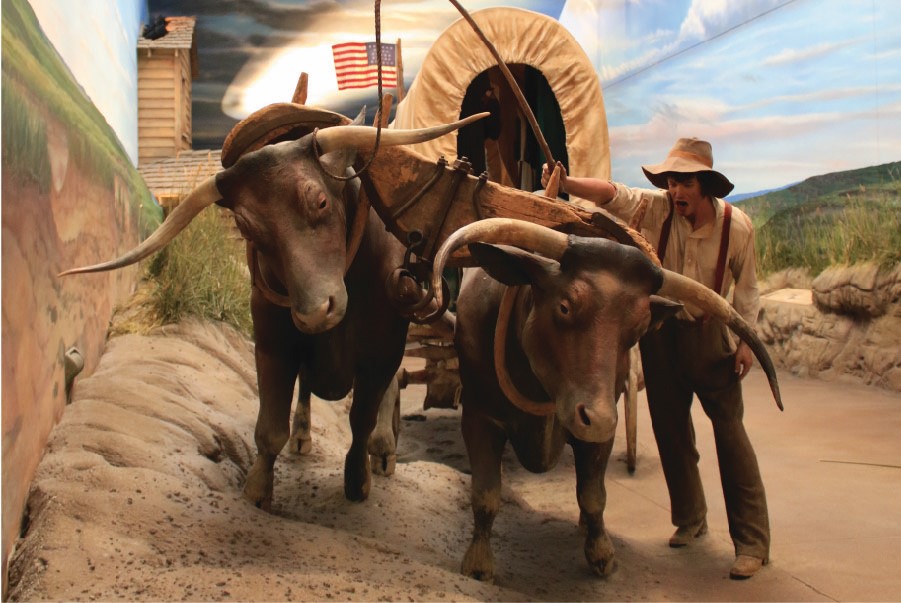
Origins of the Oregon Trail
The Archway tells the stories of the adventurers, pioneers, and innovators who traveled the Great Platte River Road through the land that would become the state of Nebraska. Some were heroes. Some were scoundrels. Many of them were ordinary people who made an extraordinary journey. In the process, they all helped to build America. It’s an enterprise that continues to this day. Here is part one of the story of the Oregon Trail.
Europeans first started exploring the land that would later become America’s Northwest in the 1700s. That’s when French and English frontiersmen began searching for a Northwest Passage, a possible river route across the continent to the Pacific Ocean. By the 1790s, ships from the Western Region of North America had already begun crossing the Pacific Ocean to China. They would trade the furs of beaver and sea otters that were harvested in North America for Chinese tea, silks, and spices. The Chinese goods were then taken back to Boston for sale.
After President Thomas Jefferson completed the Louisiana Purchase in 1803, he sent the Lewis and Clark Corps of Discovery to the region. They were sent to map the newly acquired territory and to find a practical route across the western half of the continent. Jefferson also wanted to establish an American presence in the Northwest before some European power could try to claim it. Lewis and Clark didn’t find a river route to the Pacific. But, they returned from their adventure with more than 100 maps of the territory. They also brought back information about the people, resources, and terrain of the Northwest that inspired the explorers who followed in their footsteps.
In 1812, Robert Stuart and a group of fur traders took a difficult northern route through the mountains to Fort Astoria. The fort was located at the mouth of the Columbia River in what is now Oregon. Fort Astoria was the first American settlement on the Pacific Coast of North America and was the primary trading post for the Pacific Fur Company. Stuart had heard that there was a much easier path through the mountains to the south. So, he veered further south on his trip back east. While traveling along the mountains heading south, Stuart and his men found a wide path across the Continental Divide. The path through the mountains would become essential to the wagon train pioneers who would follow many years later. This route became known as the South Pass.
Through the land that would later become Nebraska, Stuart and his party followed the path along the Platte River. By the time Stuart and his men returned, they had blazed a southern path that stretched all the way from the Columbia River in what is now Oregon to St. Louis, Missouri. They had traveled most of the path that would eventually become the Oregon Trail.
In the 1820s, the fur trapper Jedediah Smith, following advice from a group of Crow Indians, took the South Pass across the Continental Divide heading west. Unlike Stuart before him, Smith freely shared information about the pass. When he wrote a letter describing his journey to the U.S. Secretary of War in 1830, the location of the South Pass became public knowledge. Smith went on to become a great promoter of the Pacific Northwest and the land that would later become Oregon. His reports spurred the growth of the fur trade. They influenced the expansionist views of the politicians in Washington. And, Smith boosted an interest among Americans in securing the Northwest territory for the United States.
Of course, western exploration on the part of Americans from the east looked much more like an invasion to the Native Americans. They had already called the continent home for hundreds of years. As the United States expanded westward, thousands of Native Americans died due to conflict and disease. And, thousands more became displaced by the U.S. military and the white emigrants.
By the mid-1800s, fashion in Europe changed and the price of furs plunged. Many of the fur traders who had first explored the West became scouts for the Army or guides for the wagon trains of pioneers that started coming from the east. The stream of fur traders and explorers who had invaded Native American lands earlier in the century would soon become a tidal wave of emigrants moving westward on the Oregon Trail.
Learn more about our history when you visit these other Kearney area attractions:
Fort Kearny State Historical Park – http://outdoornebraska.gov/fortkearny/
The Trails and Rails Museum – http://www.bchs.us/
The Classic Car Collection – https://www.classiccarcollection.org/
The G.W. Frank Museum of History and Culture – https://www.unk.edu/offices/frankhouse/
The Museum of Nebraska Art – https://mona.unk.edu/mona/
The Nebraska Firefighter’s Museum – https://nebraskafirefightersmuseum.org/


